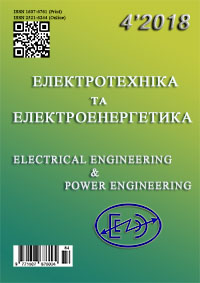EDGE-BASED VECTOR FUNCTIONS FOR APPROXIMATION OF ELECTROMAGNETIC FIELD IN VOLUME AND SURFACE FINITE ELEMENTS
DOI:
https://doi.org/10.15588/1607-6761-2018-4-4Keywords:
finite element method, volume and surface vector basis functionsAbstract
Purpose. Analysis of the properties of Edge-Based vector of basis functions for the volume elements and working surface Edge-Based FEM vector of basis functions for approximating the vector values of the electromagnetic field in the surface integrals.
Methodology. Based on the properties of simplex coordinates, the mathematical model of Edge-Based vector of basic functions for volume, and for the surface elements is proposed.
Findings. The analysis of Edge-Based vector basis functions for the finite element method (FEM) is performed. Based on the analysis, Edge-Based functions for surface elements (triangles) are proposed. The properties of Edge-Based basis functions are obtained, which make it possible to more accurately simulate a magnetic field, eddy currents and losses in comparison with Nodal-Based vector basis functions. The proposed mathematical model shows the orthogonality of the proposed system Edge-Based vector basis functions, which allows their use in FEM. Moreover, it is shown that the tangent component of a vector field, represented as a linear combination of a system of both volume and surface Edge-Based basis functions on the edge of an element, is equal to the coefficient of the linear combination corresponding to the given edge. This property allows us to combine the volume and surface integrals of the FEM into one system of linear equations.
Originality. The originality of the proposed mathematical model is the form, which makes it possible to go from volume integrals to surface integrals and merge volume and surface integrals of FEM into one system of linear equations. This allows you to significantly reduce the dimension of the problem and, as a result, reduce the resource intensity of the method and increase its speed without significant loss of accuracy.
Practical value. The Edge-Based vector basis functions for volume and surface finite elements were used in the developed software package ELMAD-3D, designed to calculate losses and overheating from the leakage fields of power transformers and reactors. The use of surface Edge-Based vector basis functions allowed us to significantly increase the speed of calculation methods and reduce their resource intensity.
References
[1] Sil'vester, P. L., Ferrari, R. L. (1986). Metod konechnykh elementov dlya radioinzhenerov i inzhenerov-elektrikov. Moscow, Mir, 229. (in Russian).
[2] Ren, Z. (2002). T-Ω Formulation for Eddy Current Problems in Multiply Connected Regions. IEEE Trans. Mag. 38, 2, 557-560.
[3] Albertz, D., Henneberger, G. (2000). On the Use of the New Edge Based -, Formulation for the Calculation of Time-Harmonic, Stationary and Transient Eddy Current Field Problems. IEEE Trans. Mag. 36, 4, 818-822.
[4] Karl Hollaus and Oszkar Biro. (2005). Comparison of Tetrahedral Edge Finite-Elements Using Different Potential Formulations. IEEE Trans. Mag. 41, 5, 1676-1679.
[5] Miklos KUCZMANN Nodal and Edge Finite. (2012). Element Analysis of Eddy Current Field Problems / Miklos KUCZMANN. PRZEGLAD ELEKTROTECHNICZNY. 12. ISSN 0033-2097 - R. 84NR, 194-197.
[6] Susnjic, L. (2008). 3D finite-element determination of stray losses in power transformer. Electric Power System Research 78, 1814-1818.
[7] Damir Žarko, Zlatko Maljković, Stjepan Štefan. (2006). Calculation of Losses in the Core Clamps of a Transformer Using 3-D Finite-Element Method / Damir Žarko, Zlatko Maljković, Stjepan Štefan // First Macedonian - Polish Symposium on Applied Electromagnetics (SAEM 2006): proceedings - Cvetkovski, Goga (ur.). 1-4.
[8] Gerard Meunier. (2008). The Finite Element Method for Electromagnetic Modeling. ISTE and Wiley. 601.
[9] Wagner B. (2008). Error Evaluation of Surface Impedance Boundary Conditions With Magnetic Vector Potential Formulation on a Cylindrical Test Problem. IEEE Trans. on Magn. 44, 6. 734-737.
[10] Ida N. (2011). High Order Surface Impedance Boundary Conditions with the A-ϕ Formulation. FACTA UNIVERSITATIS, Ser.: Elec. Energ. 24, 2, 147-155.
[11] Ostrenko, M. V. (2016). Power Transformers and Reactors Structure Losses and Temperatures Calculation Using Surface Impedance Boundary Conditions / Maxym Ostrenko, Bogdan Andriienko, Sergei Tikhovod and Denys Prychynenko // 1-st IEEE Conference Advances in Magnetics AIM. 14-16. (in Russian).
[12] Ostrenko, M. V., Tikhovod, S. M. (2016). Raschet poter' v elementakh Konstruktsii Silovykh Transformatorov i Reaktorov Metodom Konechnykh Elementov s Granichnymi usloviyamiyami Impedansnogo Tipa. Yelektrotekhníka i yelektroyenergetika, 2, 33-42. (in Russian).
[13] Demidovich, B. P., Maron, I. A., Shuvalova, E. Z. (1967). Chislennyye metody analiza. Priblizheniye funktsiy, differentsial'nyye i integral'nyye uravneniya. Moscow, Nauka, 368.
[14] Andriienko, B. U. (2012). Komp'yuterna programa "Programa rozrakhunku trivimrnogo magntnogo polya, vikhrovikh strumv, vtrat ta temperatur u silovikh transformatorakh ta reaktorakh elmag-3d" Svdotstvo pro restratsyu avtorskogo prava na tvr 41639. Derzhavna sluzhba ntelektualno vlasnost ukrani.
Downloads
Published
How to Cite
Issue
Section
License
Copyright (c) 2019 M.V. Ostrenko

This work is licensed under a Creative Commons Attribution 4.0 International License.
Creative Commons Licensing Notifications in the Copyright Notices
Authors who publish with this journal agree to the following terms:
Authors retain copyright and grant the journal right of first publication with the work simultaneously licensed under aCreative Commons Attribution License that allows others to share the work with an acknowledgement of the work's authorship and initial publication in this journal.
Authors are able to enter into separate, additional contractual arrangements for the non-exclusive distribution of the journal's published version of the work (e.g., post it to an institutional repository or publish it in a book), with an acknowledgement of its initial publication in this journal.
Authors are permitted and encouraged to post their work online (e.g., in institutional repositories or on their website) prior to and during the submission process, as it can lead to productive exchanges, as well as earlier and greater citation of published work.

